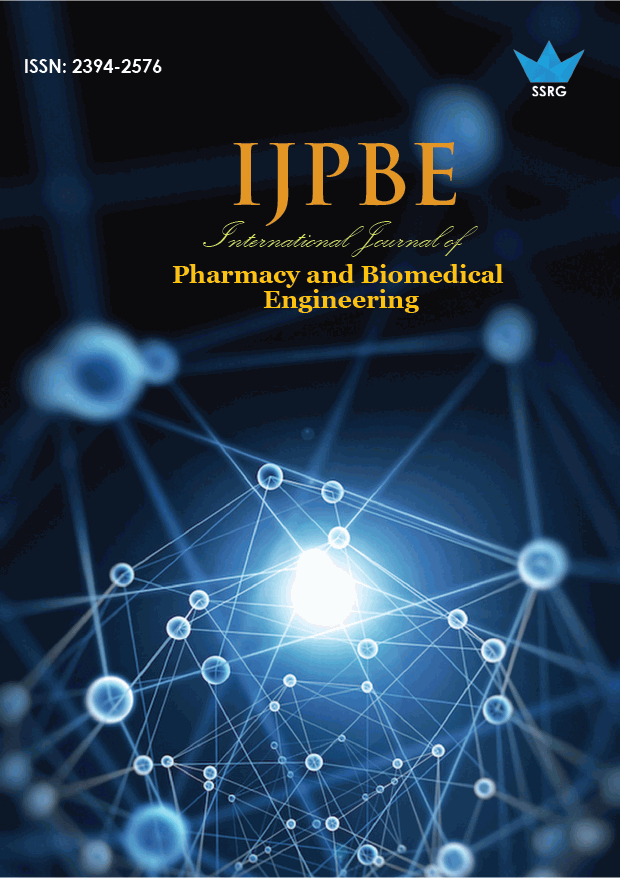Antimicrobial Activity of Chloroform and Methanolic Leaf Extract of Odina Wodier Roxb

| International Journal of Pharmacy and Biomedical Engineering |
| © 2019 by SSRG - IJPBE Journal |
| Volume 6 Issue 1 |
| Year of Publication : 2019 |
| Authors : Pavithra.T, Tamizh Mani T, Shiju .L, Rajan .M. Siva Kumar. B |
How to Cite?
Pavithra.T, Tamizh Mani T, Shiju .L, Rajan .M. Siva Kumar. B, "Antimicrobial Activity of Chloroform and Methanolic Leaf Extract of Odina Wodier Roxb," SSRG International Journal of Pharmacy and Biomedical Engineering, vol. 6, no. 1, pp. 40-45, 2019. Crossref, https://doi.org/10.14445/23942576/IJPBE-V6I1P106
Abstract:
The leaves of Odina wodier Roxb were collected from the forest in Karnataka district dried, powdered and extracted with Pet ether, chloroform, ethyl acetate and methanol. These crude extracts were tested for antimicrobial activity by the agar diffusion method. The extracts found to be active were subjected to, the extracts were prepared according to the MIC, and an antimicrobial susceptibility test was carried out using the agar well diffusion method. All the extracts showed antimicrobial activity against the tested strains. But the polar extracts showed a greater antibacterial potential as compared to the non-polar extracts. The methanolic extract was the most active. The present study showed the effectiveness of the crude plant extract against the tested bacterial strains. It indicated the potential use of the extract as an antimicrobial agent for the control of infectious diseases.
Keywords:
Odina wodier Roxb, Well diffusion assay, Antimicrobial activity.
References:
[1] Mathur A, Bhat R, Prasad GBKS, Dua VK, Verma SK and Agarwal PK. “Antimicrobial activity of plants traditionally used as medicines against some pathogens”. Rasyan J chem.2010; Vol.3, No.4, 615-620.
[2] Valli G, Jeyalakshmi M. “Preliminary phytochemical and Antioxidant study of Odina wodier leaf extract.” Asian J Phceu Res. 2012;2(4):153-55.
[3] Senthamizhselvi C. “Traditional knowledge of medicinal plants.” Global Res Analy. 2013;2(12):230-33.
[4] Avinash KR, Jyothi MJ, Ashok kumar CK. Lannea coromendelica: The Researcher's Tree. J Pharma Res. 2011;4(3):577-79.
[5] Prabhakaran M, Sundarapandian SM, Elumala S. “Phytochemical studies and antibacterial activity of the leaf, bark and root powder of Odina wodier Roxb”. Bioscie Biotech Res Asia. 2010;7(2): 857-77.
[6] Sathish R, Mohd HA, Natarajan K, Lalitha KG. “Evaluation of wound healing and antimicrobial activity of lannea coromandelica (houtt) merr”. J Pharma Res. 2010; 3(6):1225- 28.
[7] Alavijeh PK and Sharma D. “A study of antimicrobial activity of few medicinal herbs”. Asian J of Plant Sci and Research, 2012; 2 (4):496-502.
[8] Dabur R, Gupta A, Mandal TK, Singh DD, Bajpai V, Gurav AM, Lavekar GS. “Antimicrobial activity of some Indian medicinal plants”. Afr. J. Trad. CAM (2007) 4 (3): 313 – 318.
[9] Gouranga D, Durbadal O, Bolay B, Monisankar S, Soma G, Suman D. “Evaluation of antimicrobial potentialities of leaves extract of the plant cassia, tora Linn”. J Phyto. 2010;2(5):64–72.
[10] Premjanu N, Jaynthy C. “Identification and characterization of the antimicrobial metabolite from an endophytic fungus, Colletotrichum gloeosporioides isolated from Lannea corammendalica”. Int J ChemTech Res. 2014-15;7(01):369- 74.
[11] Lohithasu D, Hema ND, Ramana KV, Murthy. “Physicochemical and microbial studies of lannea gum”. Int Res J Pharma. 2017; 8 (4): 50-58.
[12] Ayyappan, S.R., R. Srikumar and R. Thangaraj. Int J of Microbiology Rese, (2010);1(2), 67-71.

 10.14445/23942576/IJPBE-V6I1P106
10.14445/23942576/IJPBE-V6I1P106